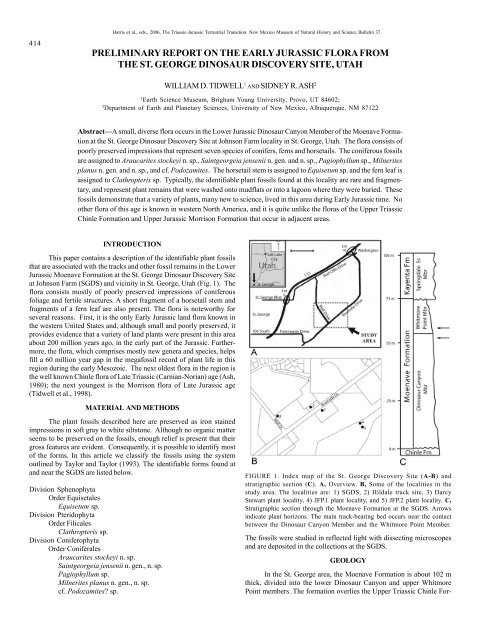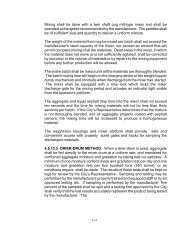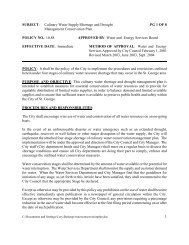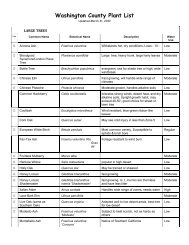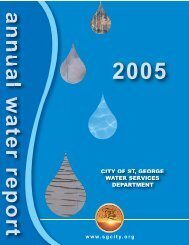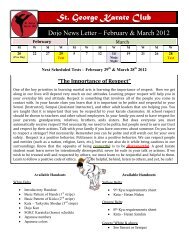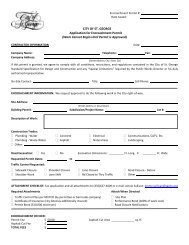You also want an ePaper? Increase the reach of your titles
YUMPU automatically turns print PDFs into web optimized ePapers that Google loves.
414<br />
Harris et al., eds., 2006, The Triassic-Jurassic Terrestrial Transition. New Mexico Museum <strong>of</strong> Natural History and Science Bulletin 37.<br />
PRELIMINARY REPORT ON THE EARLY JURASSIC FLORA FROM<br />
THE ST. GEORGE DINOSAUR DISCOVERY SITE, UTAH<br />
WILLIAM D. TIDWELL 1 AND SIDNEY R. ASH 2<br />
1<br />
Earth Science Museum, Brigham Young University, Provo, UT 84602;<br />
2<br />
Department <strong>of</strong> Earth and Planetary Sciences, University <strong>of</strong> New Mexico, Albuquerque, NM 87122<br />
Abstract—A small, diverse flora occurs in the Lower Jurassic Dinosaur Canyon Member <strong>of</strong> the Moenave Formation<br />
at the <strong>St</strong>. <strong>George</strong> Dinosaur Discovery Site at Johnson Farm locality in <strong>St</strong>. <strong>George</strong>, Utah. The flora consists <strong>of</strong><br />
poorly preserved impressions that represent seven species <strong>of</strong> conifers, ferns and horsetails. The coniferous fossils<br />
are assigned to Araucarites stockeyi n. sp., Saintgeorgeia jensenii n. gen. and n. sp., Pagiophyllum sp., Milnerites<br />
planus n. gen. and n. sp., and cf. Podozamites. The horsetail stem is assigned to Equisetum sp. and the fern leaf is<br />
assigned to Clathropteris sp. Typically, the identifiable plant fossils found at this locality are rare and fragmentary,<br />
and represent plant remains that were washed onto mudflats or into a lagoon where they were buried. These<br />
fossils demonstrate that a variety <strong>of</strong> plants, many new to science, lived in this area during Early Jurassic time. No<br />
other flora <strong>of</strong> this age is known in western North America, and it is quite unlike the floras <strong>of</strong> the Upper Triassic<br />
Chinle Formation and Upper Jurassic Morrison Formation that occur in adjacent areas.<br />
IN<strong>TR</strong>ODUCTION<br />
This paper contains a description <strong>of</strong> the identifiable plant fossils<br />
that are associated with the tracks and other fossil remains in the Lower<br />
Jurassic Moenave Formation at the <strong>St</strong>. <strong>George</strong> Dinosaur Discovery Site<br />
at Johnson Farm (SGDS) and vicinity in <strong>St</strong>. <strong>George</strong>, Utah (Fig. 1). The<br />
flora consists mostly <strong>of</strong> poorly preserved impressions <strong>of</strong> coniferous<br />
foliage and fertile structures. A short fragment <strong>of</strong> a horsetail stem and<br />
fragments <strong>of</strong> a fern leaf are also present. The flora is noteworthy for<br />
several reasons. First, it is the only Early Jurassic land flora known in<br />
the western United <strong>St</strong>ates and, although small and poorly preserved, it<br />
provides evidence that a variety <strong>of</strong> land plants were present in this area<br />
about 200 million years ago, in the early part <strong>of</strong> the Jurassic. Furthermore,<br />
the flora, which comprises mostly new genera and species, helps<br />
fill a 60 million year gap in the megafossil record <strong>of</strong> plant life in this<br />
region during the early Mesozoic. The next oldest flora in the region is<br />
the well known Chinle flora <strong>of</strong> Late Triassic (Carnian-Norian) age (Ash,<br />
1980); the next youngest is the Morrison flora <strong>of</strong> Late Jurassic age<br />
(Tidwell et al., 1998).<br />
MATERIAL AND METHODS<br />
The plant fossils described here are preserved as iron stained<br />
impressions in s<strong>of</strong>t gray to white siltstone. Although no organic matter<br />
seems to be preserved on the fossils, enough relief is present that their<br />
gross features are evident. Consequently, it is possible to identify most<br />
<strong>of</strong> the forms. In this article we classify the fossils using the system<br />
outlined by Taylor and Taylor (1993). The identifiable forms found at<br />
and near the SGDS are listed below.<br />
Division Sphenophyta<br />
Order Equisetales<br />
Equisetum sp.<br />
Division Pteridophyta<br />
Order Filicales<br />
Clathropteris sp.<br />
Division Coniferophyta<br />
Order Coniferales<br />
Araucarites stockeyi n. sp.<br />
Saintgeorgeia jensenii n. gen., n. sp.<br />
Pagiophyllum sp.<br />
Milnerites planus n. gen., n. sp.<br />
cf. Podozamites? sp.<br />
FIGURE 1. Index map <strong>of</strong> the <strong>St</strong>. <strong>George</strong> Discovery Site (A-B) and<br />
stratigraphic section (C). A, Overview. B, Some <strong>of</strong> the localities in the<br />
study area. The localities are: 1) SGDS, 2) Hildale track site, 3) Darcy<br />
<strong>St</strong>ewart plant locality, 4) JFP.1 plant locality, and 5) JFP.2 plant locality. C,<br />
<strong>St</strong>ratigraphic section through the Moenave Formation at the SGDS. Arrows<br />
indicate plant horizons. The main track-bearing bed occurs near the contact<br />
between the Dinosaur Canyon Member and the Whitmore Point Member.<br />
The fossils were studied in reflected light with dissecting microscopes<br />
and are deposited in the collections at the SGDS.<br />
GEOLOGY<br />
In the <strong>St</strong>. <strong>George</strong> area, the Moenave Formation is about 102 m<br />
thick, divided into the lower Dinosaur Canyon and upper Whitmore<br />
Point members. The formation overlies the Upper Triassic Chinle For-
mation and is in turn overlain by the Springdale Sandstone Member <strong>of</strong><br />
the Lower Jurassic Kayenta Formation (Fig. 1C; Kirkland et al., 2002;<br />
Lockley et al., 2004; Lucas et al., 2005). The Springdale Sandstone<br />
Member was originally considered the upper member <strong>of</strong> the Moenave<br />
Formation (Hintze, 2005). The Triassic-Jurassic boundary is probably<br />
located within the Dinosaur Canyon Member (A. Milner, personal<br />
commun.). The Dinosaur Canyon Member is a reddish-brown siltstone<br />
and sandstone, and the Whitmore Point Member a recessive unit <strong>of</strong> red<br />
and white siltstone, mudstone, and limestone near the main track-bearing<br />
bed in which the fossil plants occur. At many <strong>of</strong> the track sites, numerous<br />
fossil track-bearing horizons have been identified, two associated<br />
with the fossil plants described herein. The fossil plants have been collected<br />
from near the top <strong>of</strong> the Dinosaur Canyon Member and near the<br />
base <strong>of</strong> the Whitmore Point Member (Fig. 1C). Other types <strong>of</strong> fossils at<br />
the track sites include arthropod, horseshoe crab, and beetle trackways,<br />
fish remains, fish swim trails, and algal mats (A. Milner, personal<br />
commun.).<br />
SYSTEMATIC PALEONTOLOGY<br />
Division Sphenophyta<br />
Order Equisetales<br />
Family Equisetaceae<br />
Genus Equisetum Linné<br />
Discussion: Harris (1961) discussed the usage <strong>of</strong> the generic<br />
terms, Equisetum vs. Equisetites, for fossil forms similar to living Equisetum.<br />
Although he had used Equisetites previously (Harris, 1926, 1931),<br />
Harris reconsidered this decision and decided to use Equisetum, because<br />
“no morphological differences have ever been proved between Equisetum<br />
and Equisetites…” (Harris, 1961, p. 14). In fact, the fossil and extant<br />
forms he examined exhibit strikingly morphological similarities. We follow<br />
Harris (1961) and assign the single known equisetalean fossil known<br />
from this locality to Equisetum because we cannot see any difference<br />
between the stem <strong>of</strong> living Equisetum and the specimen at the Johnson<br />
Farm locality.<br />
Equisetalean fossils are poorly known in the Triassic and Jurassic<br />
<strong>of</strong> North America. They include a few specimens <strong>of</strong> small stems described<br />
from the Upper Triassic <strong>of</strong> Arizona by Daugherty (1941) and<br />
Ash (2005). Daugherty (1941) also described some Late Triassic spores<br />
that he attributed to Equisetum, but they were later found in small coniferous-like<br />
cones by Ash (1972). The Jurassic representatives <strong>of</strong> Equisetum<br />
described from western North America are found at a few localities<br />
in the Upper Jurassic Morrison Formation (Brown, 1972; Tidwell, 1990;<br />
Ash and Tidwell, 1998; Tidwell et al., 1998), as well as the Jurassic <strong>of</strong><br />
Oregon and Montana (Fontaine, 1905a, b) and Oaxaca, Mexico (Wieland,<br />
1913; Delevoryas and Gould, 1971, 1973)<br />
Geologic range: Triassic to Recent.<br />
Equisetum sp.<br />
Figure 2A<br />
Material: SGDS.569.<br />
Description: This species is represented by a single specimen <strong>of</strong><br />
a narrow stem about 5 mm wide and about 5 cm long that shows a single<br />
node. The axis is furrowed and the node is marked externally by the<br />
proximal ends <strong>of</strong> narrow commissural furrows and by a ridge formed by<br />
an in situ nodal diaphragm. Internodes are at least 34 mm long and, as a<br />
result, the leaves do not overlap adjacent nodes. The leaf sheath is 15<br />
mm in length and is composed <strong>of</strong> 16 tapering, acutely pointed leaf teeth<br />
(eight on each side <strong>of</strong> the flattened axis). The free teeth have a single ridge<br />
above the midvein and extend beyond the node for about 9 mm.<br />
Comparison: Equisetum sp. is somewhat similar to E. doratodon<br />
Harris, E. muensterii (<strong>St</strong>ernb.) Schimper, E. laevis Halle, and E.<br />
grosphodon Harris from the Rhaetic flora <strong>of</strong> Scoresby Sound, East<br />
415<br />
FIGURE 2. Equisetales (A) and Filicales (B, C) from the Johnson Farm<br />
locality. A, <strong>St</strong>em <strong>of</strong> Equisetum sp. (SGDS.569). A single node is present on<br />
this narrow stem as well as eight longitudinal ridges. B-C, Fragments <strong>of</strong> the<br />
palmate leaf Clathropteris sp. B, Bases <strong>of</strong> several pinnae. The strong midribs<br />
<strong>of</strong> the pinnae are prominent in this fossil (SGDS.465, x 1). C, Central part<br />
<strong>of</strong> a leaf showing the net venation characteristic <strong>of</strong> this leaf (SGDS.503).<br />
Greenland (Harris, 1931). It differs by being narrower (6 vs. 15-20 mm)<br />
than E. doratodon, having shorter free teeth (9 vs. 12 mm), a larger<br />
number <strong>of</strong> leaves (16 vs. 12 leaves) than E. muensterii, having a ridge<br />
above the midvein rather than a furrow as in E. laevis, and a thinner stem<br />
(6 vs. 25 mm) and far fewer leaves (16 vs. 30-40 leaves) than E.<br />
grosphodon.<br />
Discussion: As has been noted by Seward (1898), the presence<br />
<strong>of</strong> a transverse nodal diaphragm enables axes to resist total compaction in<br />
the nodal region by burial. No cuticle, cones, rhizomes, or individual<br />
transverse nodal diaphragms are present.<br />
Division Pterophyta<br />
Family Dipteridaceae<br />
Genus Clathropteris Brongniart, 1828<br />
Discussion: This fern has distinctive, palmately compound leaves<br />
that are borne on the ends <strong>of</strong> stout rachises that arise from underground<br />
rhizomes. The pinnae have coarsely toothed margins and the leaf has net<br />
venation with blind vein endings in the meshes. Fertile specimens have<br />
small, round sori scattered on the lower leaf surfaces within the vein<br />
meshes.<br />
Comparison: In Clathropteris and the similar genus<br />
Dictyophyllum, the pinnae extend outward from rather long trusses that<br />
formed from symmetrical divisions at the tip <strong>of</strong> the petiole. They then<br />
bend in a horizontal plane (Oishis and Yamasita, 1936). The pinnae<br />
margins are denticulate in both genera and the major distinction between<br />
them is the more regular and rectangular shape <strong>of</strong> the meshes formed by<br />
the secondary and tertiary veins in Clathropteris than in Dictyophyllum.<br />
The secondary venation in Clathropteris also generates a pattern perpendicular<br />
to the veins inserted to the rachis (M.E. Popa, personal<br />
commun.)<br />
Geologic range: Late Triassic through the Middle Jurassic.<br />
Clathropteris sp.<br />
Figure 2B, C<br />
Material: SGDS.465, 503.<br />
Discussion: This species is represented by only the two small<br />
fragmentary specimens <strong>of</strong> leaves shown in Figures 2B and C. Although<br />
small, enough is preserved to show that the specimens are the remains <strong>of</strong><br />
palmately compound leaves that have net venation and marginal teeth on<br />
the pinnae. All <strong>of</strong> these features are characteristic <strong>of</strong> the genus<br />
Clathropteris. However, not enough is preserved for comparisons or to<br />
assign them to a species.
416<br />
Division Coniferophyta<br />
Order Coniferales<br />
Family Araucariaceae<br />
Genus Araucarites Presl (in <strong>St</strong>ernberg, 1838)<br />
Discussion: Although this genus was originally used for coniferous<br />
twigs, it has come to be used for isolated cones and cone parts that<br />
appear to be araucarian (Harris, 1935; Miller, 1977). Other genera used<br />
less frequently for such fossils include Primaraucaria Bock (1954),<br />
Dammarites Presl (in <strong>St</strong>ernberg, 1838), and Aachenia Knobloch (1972).<br />
Somewhat similar fossils have been reported from the Late Triassic <strong>of</strong><br />
eastern North America by Bock (1954, 1969), but the fossils have been<br />
lost and the discoveries cannot be confirmed. Although the fossils described<br />
here are not the oldest known cone-scale complexes yet attributed<br />
to the genus Araucarites, their presence in the earliest Jurassic<br />
seems to support the contention by Miller (1977) that the Araucariaceae<br />
extended into the Triassic.<br />
Geologic range: Late Triassic-Cretaceous.<br />
Araucarites stockeyi new species<br />
Figure 3A-K<br />
Holotype: SGDS.515A and counterpart SGDS.515B.<br />
Paratypes: SGDS.557A, B, C.<br />
Derivation <strong>of</strong> name: We take special pleasure in naming this<br />
species after Dr. Ruth <strong>St</strong>ockey (University <strong>of</strong> Edmonton, Edmonton,<br />
Canada) who has devoted so much <strong>of</strong> her pr<strong>of</strong>essional career to the study<br />
<strong>of</strong> the living and fossil Araucariaceae.<br />
Diagnosis: Detached ovulate cone-scale complexes, bract wedgeshaped<br />
in outline, about 8-12 mm wide, 11-12 mm long, base broad,<br />
lateral margins straight and smooth, apical margin rounded and smooth,<br />
bearing a free tip or distal beak about 1 mm long. Ovule medially placed<br />
in proximal part <strong>of</strong> bract, obovate, base narrow, lateral margins slightly<br />
curving, smooth, apical margin rounded, smooth, about 5-6 mm wide<br />
near top, 8 mm long, 1 mm thick in uncompressed specimens, surface<br />
showing narrow longitudinal striations.<br />
Description: This species is represented by nearly a dozen impressions<br />
<strong>of</strong> cone-scale complexes and isolated ovules, the best <strong>of</strong> which<br />
are illustrated in Figure 3. The bracts are thick and sturdy and give the<br />
impression <strong>of</strong> being woody. Typically, the ovules on the cone-scale<br />
complexes are not totally compressed and show varying amounts <strong>of</strong><br />
relief (Figs. 3A, C, G). When first collected, the ovule in one specimen<br />
was attached to the bract by a thin layer <strong>of</strong> carbonaceous material that<br />
later disintegrated while being examined. The resulting isolated ovule<br />
(Figs. 3F, G) compares closely with some <strong>of</strong> the isolated ovules occurring<br />
naturally in the rock (Fig. 3I). No clear evidence <strong>of</strong> an ovuliferous<br />
scale or ligule is present on any <strong>of</strong> the specimens.<br />
The collection also contains the compressed remains <strong>of</strong> two cones<br />
that are tentatively referred to this species. Both specimens represent<br />
cones that have been compressed somewhat laterally. One specimen<br />
(Fig. 3J) shows 6-8 poorly preserved and loosely arranged cone-scale<br />
complexes extending outward from the cone axis, which is about 2 mm<br />
broad. The bracts are wedge-shaped and are about 7-9 mm long and<br />
about 5 mm broad. They show faint, longitudinal striations but there is<br />
no evidence <strong>of</strong> an ovule present on any <strong>of</strong> these bracts. The other cone<br />
specimen is more difficult to interpret because the axis is not preserved<br />
in the specimen (Fig. 3K). Evidently, the axis was in the counterpart,<br />
which is not in the collection. Remains <strong>of</strong> a number <strong>of</strong> cone-scale complexes<br />
are evident at various levels extending into the matrix <strong>of</strong> this<br />
specimen and arranged as if they had been attached to an axis when<br />
buried. The scales are not entirely exposed but they appear to have been<br />
wedge-shaped and about 5 mm wide. The surfaces <strong>of</strong> the scales show<br />
strong longitudinal plications about 0.7 mm wide, but once again there is<br />
no evidence <strong>of</strong> ovules on the scales. The cone-scale complexes on both <strong>of</strong><br />
these specimens are smaller than the isolated forms.<br />
FIGURE 3. A-H, Holotype <strong>of</strong> Araucarites stockeyi n. sp. (SGDS.515) and I-<br />
J, cf. Araucarites stockeyi n. sp. from the SGDS. A, Unusually broad conescale<br />
complex with clearly differentiated and slightly compressed ovule.<br />
The edge <strong>of</strong> what is probably the cone scale is visible below (arrowhead).<br />
Note the narrow longitudinal striations on the surface <strong>of</strong> the ovule. B,<br />
Typical compressed cone-scale complex with a barely visible ovule<br />
(SGDS.514B). The counterpart is shown in F. C, Paratype (SGDS.557B)<br />
cone-scale complex showing the clearly defined mold <strong>of</strong> the uncompressed<br />
ovule. A thick layer <strong>of</strong> carbonaceous material that was beneath the ovule is<br />
visible in the ovule cavity. The counterpart and the ovule are shown in D.<br />
The free tip on the apical margin is visible. D, Paratype (SGDS.557A)<br />
counterpart <strong>of</strong> the cone-scale complex in C, and the cast <strong>of</strong> the ovule in the<br />
lower right which became detached during examination <strong>of</strong> the fossil in C.<br />
The mold <strong>of</strong> the seed is barely visible on the bract. Note the narrow<br />
longitudinal striations on both the seed and in the mold. E, <strong>St</strong>rongly<br />
compressed isolated ovule (SGDS.559). Compare with the isolated ovule in<br />
H. The narrow medial ridge at the base <strong>of</strong> the fossil maybe the infilling <strong>of</strong><br />
the micropyle. F, SGDS.514A, counter-part <strong>of</strong> the specimen in B. Note the<br />
well preserved apical tip on the upper margin <strong>of</strong> the bract. G, SGDS.552,<br />
typical cone-scale complex and compressed ovule. Note that the ovule is<br />
about the same size as the isolated ovule in E. H, SGDS.555, a virtually<br />
uncompressed cast <strong>of</strong> an isolated ovule. The edges <strong>of</strong> the scale are visible<br />
along the lateral margins <strong>of</strong> the ovule (arrow). I, SGDS.556B, lateral<br />
impression <strong>of</strong> a cone that is tentatively referred to cf. A. stockeyi. In this<br />
specimen, only the basal parts <strong>of</strong> the cone-scale complexes are preserved.<br />
Note the strong longitudinal plications on the bracts. J, SGDS.516, lateral<br />
impression <strong>of</strong> a cone that is tentatively referred to cf. A. stockeyi. In this<br />
fossil, several more or less complete cone-scale complexes are preserved<br />
and are attached to what appears to be the cone axis (arrow) by narrow<br />
stalks (arrow head). K, Compression <strong>of</strong> incomplete cone showing attached<br />
cone scales (arrows). Scale bar = 1 cm.<br />
Comparisons: The fossils described here seem to compare fairly<br />
closely with the ovulate cone-scale complexes assigned to section Eutacta<br />
<strong>of</strong> the genus Araucaria because the bracts are broadly wedge-shaped and<br />
bear a short, acuminate free tip on the rounded upper margin. In addition,<br />
the scales are woody and bear a single, narrow, and medially located<br />
ovule that is retained at maturity (<strong>St</strong>ockey, 1982). Particularly interesting<br />
examples are the cone scales <strong>of</strong> Araucaria columnaris (Forster) Hooker<br />
that were described in some detail by Pant and Srivastava (1968) and A.<br />
cookii Brown reported by Seward and Ford (1906). The ovules in both<br />
species are also close to those <strong>of</strong> A. stockeyi in outline and size.<br />
Comparable fossil cone scales that have been assigned to<br />
Araucarites are widely distributed in Jurassic strata in both hemispheres<br />
<strong>of</strong> the Earth. For example, the fossils from <strong>St</strong>. <strong>George</strong> are rather similar<br />
to the cone scales attributed to Araucarites brodiei Carruthers (1869)
from the Middle Jurassic <strong>of</strong> England. The British cones are about the<br />
same size as the ones described here, have a similar wedge-shape, and<br />
bear a single broad seed (Cleal and Rees, 2003). The poorly preserved<br />
cone scale complexes described from Scotland as A. millerii Seward (1911)<br />
resemble somewhat those considered here except that the seeds are relatively<br />
narrow compared to the seeds <strong>of</strong> the new species. In the Southern<br />
Hemisphere, similar cone scales have been illustrated by <strong>St</strong>ockey (1994)<br />
from the Jurassic <strong>of</strong> New South Wales, Australia.<br />
Triassic Araucaria-like cone scales are much less common than<br />
Jurassic forms. Probably the best documented such fossils are the conescale<br />
complexes assigned to Araucarites charcotii Harris (1935) from the<br />
latest Triassic (Rhaetic) <strong>of</strong> East Greenland. Although they are nearly the<br />
same age, they differ significantly from the specimens described here.<br />
First, the fossils from Greenland are more or less diamond-shaped with<br />
long, tapered distal halves that are delicate, wedge-shaped, and sturdy<br />
with a short apical beak on the rounded apical margin in the present<br />
material. Also, the ovules in the Greenland specimens dropped before<br />
the cone scales were preserved, in contrast to A. stockeyi where most<br />
ovules are retained. Furthermore, the ovules are much larger (5-8 mm<br />
wide) in the new species than those in the Greenland specimens. The<br />
latter were probably only about 4-5 mm wide since the shallow depression<br />
in which they were located is the width <strong>of</strong> several <strong>of</strong> the cone scales.<br />
The two incomplete cones here tentatively assigned to this species (see<br />
Figs. 3J, K) resemble slightly the cone described as Aliostrobus traversei<br />
Ash (1999) from the Upper Triassic <strong>of</strong> east-central New Mexico. The<br />
plications found in the cone scales in the cones from both localities are<br />
particularly noteworthy.<br />
Discussion: It appears that the seeds <strong>of</strong> Araucarites stockeyi<br />
were <strong>of</strong>ten retained on the scale complexes at shedding as in section<br />
Eutacta. The absence <strong>of</strong> ovules in the cones and their small size maybe<br />
an indication that these two fossils are immature compared to the dispersed<br />
forms. The falling away <strong>of</strong> the seed in one specimen <strong>of</strong> the new<br />
species (Figs. 3C, D) has also been reported by <strong>St</strong>ockey (1975) in Araucaria<br />
mirabilis (Spegazzini) Calder (1953) from the Jurassic <strong>of</strong> Argentina.<br />
The presence <strong>of</strong> what most certainly are araucarian cone-scale<br />
complexes at the SGDS in the very Early Jurassic indicates that the<br />
origins <strong>of</strong> the family must lie earlier in time, such as in the Late Triassic.<br />
Interestingly, however, such fossils have not yet been identified with<br />
certainty in the underlying Chinle Formation <strong>of</strong> Late Triassic age that is<br />
widely distributed in the southwestern United <strong>St</strong>ates. However, the<br />
majority <strong>of</strong> plant fossils that are known in the Chinle occur in the lower<br />
part that is assigned to the Late Carnian/Early Norian. Thus it may be<br />
that the earliest araucarians lie in the slightly younger (Late Norian/<br />
Rhaetic) parts <strong>of</strong> the Chinle and equivalent strata in the Southwest and<br />
elsewhere.<br />
Family Uncertain<br />
Genus Saintgeorgeia new genus<br />
Type species: Saintgeorgeia jensenii n. sp.<br />
Derivation <strong>of</strong> name: After the city <strong>of</strong> Saint <strong>George</strong> where the <strong>St</strong>.<br />
<strong>George</strong> Dinosaur Discovery Site at Johnson Farm is located.<br />
Diagnosis: Leafy shoot forming flattened spray, ultimate branches<br />
in a single plane, leaves scale-like, opposite on penultimate branches,<br />
spirally arranged on ultimate branches. <strong>St</strong>aminate cones attached to ends<br />
<strong>of</strong> ultimate branches.<br />
Geologic range: Early Jurassic in southwestern Utah.<br />
Saintgeorgeia jensenii new species<br />
Figures 4A-G, 5B, C<br />
Holotype: SGDS.627A, B.<br />
Paratypes: SGDS.517A.<br />
Derivation <strong>of</strong> name: From the name <strong>of</strong> the present owner <strong>of</strong> the<br />
type locality, Paul Jensen.<br />
417<br />
Diagnosis: Leafy shoot, forming more or less flat sprays,<br />
penultimate branches straight, 3-5 mm wide, more than 17 cm long,<br />
ultimate branches slender, 2-3 mm wide, 3-5 cm long, opposite to<br />
subopposite, arising from axils <strong>of</strong> lateral leaves on penultimate branches.<br />
Leaves scale-like, single-veined, arising oppositely at intervals <strong>of</strong> about 5<br />
mm, spreading, forwardly directed, falcate, recurved, distally free, acutely<br />
pointed, base expanded, decurrent. Leaves on penultimate branches in<br />
one plane, 5 mm long, 10 mm wide at base, leaves on ultimate branches 3<br />
mm long, 10 mm wide at base and appear spirally arranged. Cones about<br />
3 cm long, 1 cm wide, attached to the ends <strong>of</strong> ultimate branches, staminate,<br />
sporophylls spirally arranged, closely attached.<br />
Description: This species is represented by several dozen, generally<br />
poorly preserved specimens. Some <strong>of</strong> the best preserved <strong>of</strong> them<br />
are shown in Figure 4. The oppositely arranged leaves are clearly evident<br />
on the lateral margins <strong>of</strong> most specimens (see Figs. 4B, C, D, G), but<br />
there is no evidence <strong>of</strong> them on the upper sides <strong>of</strong> the branches. The<br />
attachment <strong>of</strong> the staminate cone-bearing ultimate branches to the<br />
penultimate branches is shown on several specimens (e.g., Figs. 4B, D).<br />
The cones are too poorly preserved to provide detailed description <strong>of</strong><br />
sporophyll morphology. In addition, the microspores <strong>of</strong> this species as<br />
well as the ovulate cones and seeds are unknown.<br />
Comparisons: The ultimate branches with attached cones are<br />
similar to Elatides, but differ by having more flattened leaves with broader<br />
basal attachment. Spirally arranged leaves occur on both penultimate and<br />
ultimate branches in Elatides, whereas they are only present on the<br />
ultimate branches <strong>of</strong> Saintgeorgeia. Also, the male cones are smaller,<br />
nearly one-half the size, in Elatides than in Saintgeorgeia.<br />
Discussion: The leafy shoots <strong>of</strong> this species appear to have been<br />
FIGURE 4. Saintgeorgia jensenii n. gen, n. sp. from the SGDS. A, SGDS.627B,<br />
longest specimen <strong>of</strong> the penultimate branch which shows several ultimate<br />
branches and the typical short aciculate leaves. B, SGDS.517A, penultimate<br />
branch showing two ultimate branches (a) terminating in cones (b). C,<br />
SGDS.517C, counterpart <strong>of</strong> the lower part <strong>of</strong> the penultimate branch in B<br />
illustrating opposite aciculate leaves. Note the twisted appearance <strong>of</strong> the<br />
leaves. D, SGDS.517A, an ultimate branch arising from the axil <strong>of</strong> a leaf (a)<br />
on a penultimate branch and terminating at the base <strong>of</strong> a cone (b). E,<br />
SGDS.517A, apical region <strong>of</strong> a cone <strong>of</strong> this species. F, SGDS.517B, ultimate<br />
branch with attached base <strong>of</strong> cone. G, SGDS.561A, long penultimate branch<br />
showing a single ultimate branch on the right side and typical aciculate<br />
leaves.
418<br />
FIGURE 5. Sketches <strong>of</strong> selected foliage at the Johnson Farm locality. A,<br />
SGDS.558.I, the fragment <strong>of</strong> a fossil leaf in Figure 6C compared with a<br />
sketch <strong>of</strong> the upper portion <strong>of</strong> a leaflet <strong>of</strong> Podozamites distans given by<br />
Harris (1935). B, SGDS.517A, a short length <strong>of</strong> a branch showing small<br />
spirally arranged leaves. C, SGDS.517A, fertile branch <strong>of</strong> Saintgeorgia<br />
jensenii arising from the axil <strong>of</strong> a leaf on a penultimate branch <strong>of</strong> the<br />
species. Drawn from the specimen in Figure 4D.<br />
fairly robust. Since the penultimate branches that have been found are<br />
more or less straight and thick, it is probable that they were rather rigid.<br />
The opposite leaves and ultimate branches indicate that the leafy shoots<br />
formed flat sprays, perhaps similar to those <strong>of</strong> some species in the<br />
Cupressaceae. Most <strong>of</strong> the known staminate cones <strong>of</strong> this species are<br />
attached to ultimate shoots (Figs. 4A, B, D, F, 5B, C), suggesting that<br />
they were retained for sometime after formation.<br />
Genus Pagiophyllum Heer, 1881<br />
Discussion: Pagiophyllum is one <strong>of</strong> a series <strong>of</strong> morphogenera<br />
based on leaf characters that are used for mainly Mesozoic sterile coniferous<br />
foliage. As now employed, Pagiophyllum is distinguished from<br />
other genera <strong>of</strong> coniferous foliage by having uni-veined leaves that are<br />
narrowly triangular in plan view and that are less than five times their<br />
width in length. In addition, the leaves are helically arranged and diverge<br />
from the parent stem at a low angle.<br />
Geologic range: Late Triassic into the Cretaceous.<br />
Pagiophyllum sp.<br />
Figure 6D<br />
Material: SGDS.491.<br />
Description: This species is represented by a single slender axis<br />
about 1 mm wide and 10 cm long that bears more or less alternate lateral<br />
branches that are 10-30 mm long and appear flexible. The axis and the<br />
lateral branches are usually concealed by small, helically arranged leaves.<br />
The leaves are lanceolate with obtuse to acutely pointed apices. The free<br />
parts <strong>of</strong> the leaves are typically about 2 mm long and about 1 mm wide<br />
at the widest near the base. The surfaces <strong>of</strong> the leaves are smooth.<br />
Cuticle and cones are not preserved.<br />
Discussion: Comparisons between this specimen and previously<br />
described species <strong>of</strong> Pagiophyllum are essentially impossible because <strong>of</strong><br />
the lack <strong>of</strong> cuticle on the specimen. The species described by Harris<br />
(1979) from the Middle Jurassic Yorkshire <strong>of</strong> England, for instance, is<br />
based largely on cuticle, which allows for more accurate determination <strong>of</strong><br />
its species but does not allow for meaningful comparisons with<br />
Pagiophyllum sp.<br />
Genus Milnerites new genus<br />
Type species: Milnerites planus n. sp.<br />
Derivation <strong>of</strong> name: After Andrew R.C. Milner, <strong>City</strong> Paleontologist,<br />
<strong>St</strong>. <strong>George</strong>, Utah.<br />
Diagnosis: Flattened leafy shoots, leaves arranged in two ranks<br />
on opposite sides <strong>of</strong> axes, leaves decurrent, triangular to falcate in lateral<br />
view, containing a single vein.<br />
Geologic range: Early Jurassic in southwestern Utah.<br />
Milnerites planus new species<br />
Figure 6A-B<br />
Material: SGDS 513A, 558A.<br />
Derivation <strong>of</strong> name: From the Latin, planus, flat, level, in reference<br />
to the appearance <strong>of</strong> the leafy shoot <strong>of</strong> this species.<br />
Diagnosis: Shoots robust, flattened, single plane, leaves close, 2-<br />
ranked, opposite to subopposite, decurrent, coriaceous, triangular to<br />
falcate in lateral view, 3-5 mm long, 1-4 mm wide at base, apex acute,<br />
occasionally slightly curved, attached by entire base, abaxial surface<br />
convex, somewhat rounded, but not keeled; single vein, immersed, continues<br />
to near apex.<br />
Discussion: Specimens are incomplete. They are not typical conifer-type<br />
foliage and, in some cases, they appear to be more fern-like in<br />
outline. The fact that the shoots are flattened with the leaves attached in<br />
two ranks on opposite sides <strong>of</strong> axes, rather than arranged in a helical,<br />
whorled, or decussate pattern, is rather unique. It is similar in this context<br />
to some foliage <strong>of</strong> Metasequoia, but differs by not being petiolate<br />
FIGURE 6. Milnerites planus (A, B), cf. Podozamites (C), and Pagiophyllum<br />
sp. (D) from the SGDS. A-B, In these specimens <strong>of</strong> Milnerites planus (A is<br />
SGDS.558A; B is SGDS.513A), the triangular-shaped leaves are clearly<br />
opposite and single veined. The upper leaf shoot in A is not connected with<br />
the specimen in the lower part <strong>of</strong> the specimen, although it represents the<br />
same species. C, SGDS.558I, fragment <strong>of</strong> a leaflet that compares fairly<br />
closely with Podozamites. Note the parallel veins in the specimen that are<br />
typically <strong>of</strong> this genus. Compare with the drawing in Figure 5A. D, SGDS.491,<br />
leafy shoot <strong>of</strong> Pagiophyllum sp.
and having broader, shorter leaves rather than linear, needle-like leaves <strong>of</strong><br />
the latter. Milnerites planus differs from Saintgeorgeia jensenii by having<br />
different shaped leaves that are closer together and not as curved and<br />
by a flattened shoot.<br />
Genus Podozamites (Brongniart) Braun in Munster, 1843<br />
Discussion: Like Pagiophyllum, Podozamites is another in a series<br />
<strong>of</strong> morphogenera based on leaf characters that are used for mainly<br />
Mesozoic sterile coniferous foliage. Podozamites, as it is usually employed,<br />
is distinguished from the others by having linear, lanceolate<br />
leaves containing numerous parallel veins that converge apically. They<br />
are borne alternately or spirally on long shoots.<br />
Geologic range: Triassic throughout the Cretaceous.<br />
cf. Podozamites<br />
Figures 5A, 6C<br />
Material: SGDS.558A.<br />
Description and Discussion: Several small fragments <strong>of</strong> lamina<br />
showing narrow parallel veins apparently represent Podozamites. The<br />
size <strong>of</strong> the whole leaf is unknown, but the dimensions <strong>of</strong> the fragments<br />
indicate that it was probably rather small. These fragments are comparable<br />
to Podozamites distans (Presl) Braun and P. punctatus Harris from<br />
the Rhaetic Scoresby Sound flora <strong>of</strong> East Greenland (Harris, 1935) (Fig.<br />
5A). Although the lower part <strong>of</strong> the leaf shows elongate cells over the<br />
veins, no other epidermal cells are visible.<br />
SUMMARY<br />
419<br />
The flora from the SGDS is the first Early Jurassic flora reported<br />
from western North America. The majority <strong>of</strong> Early Jurassic floras are<br />
found in Eurasia. Early Jurassic floras are marked by an ascendance <strong>of</strong><br />
many Triassic types in Europe (Vakhrameev, 1991). Ferns were common,<br />
as were conifers and bennettitalean forms, in many floras <strong>of</strong> this<br />
age. Podozamites, Clathropteris, and Equisetum, present in the <strong>St</strong>. <strong>George</strong><br />
flora, were well represented in Early Jurassic floras in Eurasia. This flora<br />
and fragments <strong>of</strong> other plant material which occur at the SGDS suggests<br />
the flora was much more diverse when living and that more taxa will<br />
likely be uncovered with additional collecting at other sites within and<br />
adjacent to <strong>St</strong>. <strong>George</strong>.<br />
ACKNOWLEDGMENTS<br />
We are grateful to Andrew R.C. Milner (<strong>City</strong> Paleontologist, <strong>St</strong>.<br />
<strong>George</strong>, Utah) who was responsible for collecting the material described<br />
here and providing additional data, and to Dr. James I. Kirkland (<strong>St</strong>ate<br />
Paleontologist, Utah Geological Survey) for inviting us to study this<br />
flora. We acknowledge the assistance <strong>of</strong> Darcy <strong>St</strong>ewart, Paul Jensen and<br />
the late Layton Ott for allowing collection <strong>of</strong> fossils on their properties,<br />
Pr<strong>of</strong>essor M.E. Popa (University <strong>of</strong> Bucharest) for reviewing the manuscript,<br />
and to Dr. Brooks Britt (Department <strong>of</strong> Geology, Brigham Young<br />
University) for his assistance with the illustrations.<br />
REFERENCES<br />
Ash, S.R., 1972, Plant megafossils <strong>of</strong> the Chinle Formation, in Breed, W.J.,<br />
and Breed, C.S., eds., Investigations in the Triassic Chinle Formation:<br />
Museum <strong>of</strong> Northern Arizona, Bulletin 47, p. 23-43.<br />
Ash, S.R., 1980, Upper Triassic floral zones <strong>of</strong> North America, in Dilcher,<br />
D.L. and Taylor, T.M., eds., Biostratigraphy <strong>of</strong> fossil plants: <strong>St</strong>roudsburg,<br />
Dowden, Hutchinson and Ross, Inc., p. 153-270.<br />
Ash, S.R., 1999, An Upper Triassic upland flora from north-central New<br />
Mexico, U.S.A.: Review <strong>of</strong> Palaeobotany and Palynology, v. 105, p.<br />
183-199.<br />
Ash, S.R., 2005, A new Upper Triassic flora and associated invertebrate<br />
fossils from the basal beds <strong>of</strong> the Chinle Formation, near Cameron,<br />
Arizona: PaleoBios, v. 25, p. 17-34.<br />
Ash, S.R. and Tidwell, W.D., 1998. Plant megafossils from the Brushy Basin<br />
Member <strong>of</strong> the Morrison Formation near Montezuma Creek Trading<br />
Post, southeastern Utah, in Carpenter, K., Chure, D.J. and Kirkland, J.I.,<br />
eds., The Upper Jurassic Morrison Formation: an interdisciplinary study,<br />
part I: Modern Geology, v. 22, p.321-339.<br />
Bock, W., 1954, Primaraucaria, a new araucarian genus from the Virginia<br />
Triassic: Journal <strong>of</strong> Paleontology, v. 28, p. 32-42.<br />
Bock, W., 1969, The American Triassic flora and global distribution: Research<br />
Series, v. 3/4. North Wales, Geological Center, 406 p.<br />
Brongniart, A., 1828, Prodrome d’une histoire des végétaux fossils: Paris,<br />
F.G. Levrault, 223 p.<br />
Brown, J.T., 1972. The flora <strong>of</strong> the Morrison Formation (Upper Jurassic)<br />
<strong>of</strong> central Montana [Ph.D. dissertation]: Missoula, University <strong>of</strong> Montana,<br />
65 p.<br />
Calder, M.G., 1953, A coniferous petrified forest in Patagonia: Bulletin <strong>of</strong><br />
the British Museum (Natural History), Geology Series, v. 3, p. 99-138.<br />
Carruthers, W., 1869, On some undescribed coniferous fruits from the secondary<br />
rocks <strong>of</strong> Britain: Geological Magazine, v. 6, p. 1-7.<br />
Cleal, C.J. and Rees, P.M., 2003, The Middle Jurassic flora from <strong>St</strong>onesfield,<br />
Oxfordshire, UK: Palaeontology, v. 46, p. 739-801.<br />
Daugherty, L.H., 1941, The Upper Triassic flora <strong>of</strong> Arizona: Carnegie<br />
Institution <strong>of</strong> Washington Contributions to Paleontology, v. 526, p. 1-<br />
108.<br />
Delevoryas, T. and Gould, R.E., 1971, An unusual fossil fructification from<br />
the Jurassic <strong>of</strong> Oaxaca, Mexico: American Journal <strong>of</strong> Botany, v. 58, p.<br />
616-620.<br />
Delevoryas, T. and Gould, R.E., 1973, Investigations <strong>of</strong> North American<br />
cycadeoids: williamsonian cones from the Jurassic <strong>of</strong> Oaxaca, Mexico:<br />
Review <strong>of</strong> Palaeobotany and Palynology, v. 15, p. 27-42.<br />
Fontaine, W.M., 1905a, The Jurassic flora <strong>of</strong> Douglas County, Oregon, in<br />
Ward, L.F., Fontaine, W.M., Bibbins, A. and Wieland, G.R., eds., <strong>St</strong>atus<br />
<strong>of</strong> the Mesozoic floras <strong>of</strong> the United <strong>St</strong>ates: U.S. Geological Survey<br />
Monograph, v. 48, p. 47-145.<br />
Fontaine, W.M., 1905b, Flora <strong>of</strong> the Kootenai Formation, in Ward, L.F.<br />
Fontaine, W.M., Bibbins, A. and Wieland, G.R., eds., <strong>St</strong>atus <strong>of</strong> the Mesozoic<br />
floras <strong>of</strong> the United <strong>St</strong>ates: U.S. Geological Survey Monograph, v.<br />
48, p. 277-315.<br />
Harris, T.M., 1926, The Rhaetic flora <strong>of</strong> Scoresby Sound, east Greenland:<br />
Meddelelser om Grønland, v. 68, p. 1-147.<br />
Harris, T.M., 1931, The fossil flora <strong>of</strong> Scoresby Sound, east Greenland, part<br />
1, cryptogams (exclusive <strong>of</strong> Lycopodiales): Meddelelser om Grønland, v.<br />
85, p. 1-102.<br />
Harris, T.M., 1935, The fossil flora <strong>of</strong> Scoresby Sound, East Greenland,<br />
part 4, Ginkgoales, Coniferales, Lycopodiales and isolated fructifications:<br />
Meddelelser om Grønland, v. 112, p. 1-176.<br />
Harris, T.M., 1961, The Yorkshire Jurassic flora. I: Thallophyta-<br />
Pteridophyta: London, British Museum (Natural History), 221 p.<br />
Harris, T.M., 1979, The Yorkshire Jurassic flora. V: Coniferales: London,<br />
British Museum (Natural History), 166 p.<br />
Heer, O., 1881, Contributions a la flora fossile du Portugal: Lisbon,<br />
Comunicações dos Trabalhos do Serviços Geológicos de Portugal Lisbon<br />
series 4, Section des Travaux Geologiques du Portugal, 51 p.<br />
Hintze, L.F., 2005, Utah’s spectacular geology: how it came to be: Provo,<br />
Department <strong>of</strong> Geology, Brigham Young University, 203 p.<br />
Knobloch, E.A., 1972, Aachenia debeyi n. gen., n. sp. – eine neue Konifere<br />
aus dem Senon von Aachen: Neues Jahrbuch für Geologie und Paläontologie<br />
Monatshefte, v. 1972, p. 400-406.<br />
Kirkland, J.I., Lockley, M.G. and Milner, A.R.C., 2002, The <strong>St</strong>. <strong>George</strong><br />
dinosaur tracksite: Utah Survey Notes, v. 34, p. 4-5, 12.
420<br />
Lockley, M.G., Kirkland, J.I. and Milner, A.R.C., 2004, Probable relationships<br />
between the Lower Jurassic crocodilomorph trackways Batrachopus<br />
and Selenichnus: evidence and implications based on new finds from the<br />
<strong>St</strong>. <strong>George</strong> area southwestern Utah: Ichnos, v. 11, p. 143-149.<br />
Lucas, S.G., Tanner, L.H. and Heckert, A.B., 2005, Tetrapod biostratigraphy<br />
and biochronology across the Triassic-Jurassic boundary in northeastern<br />
Arizona: New Mexico Museum <strong>of</strong> Natural History and Science,<br />
Bulletin 29, p. 84-94.<br />
Miller, C.N., 1977, Mesozoic conifers: Botanical Review, v. 43, p. 217-280.<br />
Münster, G.G., 1843, Beiträge zur Petrefacten-Kunde 6: Bayreuth, Buchner,<br />
100 p.<br />
Oishi, S. and Yamasita, K., 1936, On the fossil Dipteridaceae: Journal <strong>of</strong> the<br />
Faculty <strong>of</strong> Science, Hokkaido Imperial University, Sapporo, v. 3, p.<br />
135-184.<br />
Pant, D.D. and Srivastava, G.K., 1968, On the cuticular structures <strong>of</strong> Araucaria<br />
(Araucarites) cutchensis (Feistamantel) comb. nov. from the<br />
Jabalpur series, India: Journal <strong>of</strong> the Linnean Society (Botany), v. 61, p.<br />
201-206.<br />
Seward, A.C., 1898, Fossil plants for students <strong>of</strong> botany and geology v. 1:<br />
Cambridge, Cambridge University Press, 452 p.<br />
Seward, A.C., 1911, The Jurassic flora <strong>of</strong> Sutherland: Transactions <strong>of</strong> the<br />
Royal Society <strong>of</strong> Edinburgh, v. 47, p. 96-709.<br />
Seward, A.C. and Ford, S.O., 1906, The Araucariaceae, recent and extinct:<br />
Royal Society <strong>of</strong> London Philosophical Transactions, ser. B, v. 198, p.<br />
305-411.<br />
<strong>St</strong>ernberg, G.K., 1820-1838, Versuch einer geognostisch-botanischen<br />
Darstellung der Flora der Vorwelt: Leipsig und Prague, v. 2, pts. 7-8, p.<br />
81-220.<br />
<strong>St</strong>ockey, R.A., 1975, Seeds and embryos <strong>of</strong> Araucaria mirabilis: American<br />
Journal <strong>of</strong> Botany, v. 62, p. 856-868.<br />
<strong>St</strong>ockey, R.A., 1982, The Araucariaceae: an evolutionary perspective: Review<br />
<strong>of</strong> Palaeobotany and Palynology, v. 37, p. 133-154.<br />
<strong>St</strong>ockey, R.A., 1994, Mesozoic Araucariaceae: morphology and systematic<br />
relationships: Journal <strong>of</strong> Plant Research, v. 107, p. 493-502.<br />
Taylor, T.N. and Taylor, E.L., 1993, The biology and evolution <strong>of</strong> fossil<br />
plants: New York, Prentice Hall, 982 p.<br />
Tidwell, W.D., 1990, Preliminary report on the megafossil flora <strong>of</strong> the<br />
Upper Jurassic Morrison Formation: Hunteria, v. 2, no. 8, p. 3-12.<br />
Tidwell, W.D., 1998, Common fossil plants <strong>of</strong> western North America, 2 nd<br />
edition: Washington, Smithsonian Institution Press, 299 p.<br />
Tidwell, W.D., Ash, S.R. and Britt, B.B., 1998, Plant megafossils from the<br />
Brushy Basin Member <strong>of</strong> the Morrison Formation near Montezuma<br />
Creek Trading Post, southeastern Utah, in Carpenter, K., Chure, D.J.<br />
and Kirkland, J.I. eds., The Upper Jurassic Morrison Formation: an<br />
interdisciplinary study, part 1: Modern Geology, v. 22, p. 321-339.<br />
Vakhrameev, V.A., 1991, Jurassic and Cretaceous floras and climates <strong>of</strong> the<br />
Earth: Cambridge, Cambridge University Press, 318 p.<br />
Wieland, G.R., 1913, The Liassic Flora <strong>of</strong> the Mixteca Alta <strong>of</strong> Mexico – its<br />
composition, age, and source: American Journal <strong>of</strong> Science, Fourth Series,<br />
v. 36, p. 251-281.


